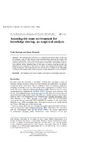Identificador persistente para citar o vincular este elemento:
https://accedacris.ulpgc.es/jspui/handle/10553/76992
| Campo DC | Valor | idioma |
|---|---|---|
| dc.contributor.author | Zárraga, Celia | en_US |
| dc.contributor.author | Bonache, Jaime | en_US |
| dc.date.accessioned | 2020-12-27T09:58:12Z | - |
| dc.date.available | 2020-12-27T09:58:12Z | - |
| dc.date.issued | 2003 | en_US |
| dc.identifier.issn | 0958-5192 | en_US |
| dc.identifier.other | WoS | - |
| dc.identifier.uri | https://accedacris.ulpgc.es/handle/10553/76992 | - |
| dc.description.abstract | The self-managed work team is an organizational structure that is much used by companies today. It is put forward as the most appropriate setting for the creation and transfer of knowledge, while protecting the source of competitive advantage. However, achieving efficiency in a work team is not without its difficulties. The literature indicates that a suitable climate minimizes these. In this study, we analyse, both theoretically and empirically, the components of that climate as well as some organizational initiatives that favour its presence. The empirical study was carried out on a sample of 363 individuals working in self-managed teams within companies, mostly multinationals, located in Spain. | en_US |
| dc.language | eng | en_US |
| dc.relation.ispartof | International Journal of Human Resource Management | en_US |
| dc.source | International Journal of Human Resource Management [ISSN 0958-5192], v. 14 (7), p. 1227-1245, (Noviembre 2003) | en_US |
| dc.subject | 5302 Econometría | en_US |
| dc.subject.other | Self-Managed Work Teams | en_US |
| dc.subject.other | Transfer And Creation Of Knowledge | en_US |
| dc.subject.other | High Care | en_US |
| dc.title | Assessing the team environment for knowledge sharing: an empirical analysis | en_US |
| dc.type | info:eu-repo/semantics/Article | en_US |
| dc.type | Article | en_US |
| dc.identifier.doi | 10.1080/0958519032000114282 | en_US |
| dc.identifier.scopus | 0344287078 | - |
| dc.identifier.isi | 000185506500009 | - |
| dc.contributor.authorscopusid | 10041560200 | - |
| dc.contributor.authorscopusid | 6603811866 | - |
| dc.description.lastpage | 1245 | en_US |
| dc.identifier.issue | 7 | - |
| dc.description.firstpage | 1227 | en_US |
| dc.relation.volume | 14 | en_US |
| dc.investigacion | Ciencias Sociales y Jurídicas | en_US |
| dc.type2 | Artículo | en_US |
| dc.contributor.daisngid | 33312344 | - |
| dc.contributor.daisngid | 1964859 | - |
| dc.description.numberofpages | 19 | en_US |
| dc.utils.revision | Sí | en_US |
| dc.contributor.wosstandard | WOS:Zarraga, C | - |
| dc.contributor.wosstandard | WOS:Bonache, J | - |
| dc.date.coverdate | Noviembre 2003 | en_US |
| dc.identifier.ulpgc | Sí | en_US |
| dc.description.jcr | 0,423 | |
| dc.description.jcrq | Q4 | |
| dc.description.ssci | SSCI | |
| dc.description.erihplus | ERIH PLUS | |
| item.fulltext | Con texto completo | - |
| item.grantfulltext | open | - |
| Colección: | Artículos | |
Citas SCOPUSTM
180
actualizado el 08-jun-2025
Citas de WEB OF SCIENCETM
Citations
141
actualizado el 08-jun-2025
Visitas
255
actualizado el 31-may-2025
Descargas
867
actualizado el 31-may-2025
Google ScholarTM
Verifica
Altmetric
Comparte
Exporta metadatos
Los elementos en ULPGC accedaCRIS están protegidos por derechos de autor con todos los derechos reservados, a menos que se indique lo contrario.
